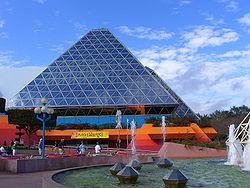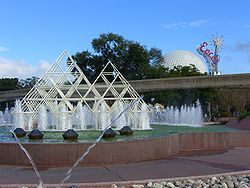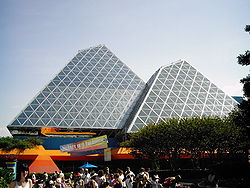| Imagination! |
Attraction history:
While the pavilion itself has technically existed since 1982, it has so far gone through three significant phases. The original
Brothers. The Makin' Memories slide presentation, a history of photography was the pre-show presentation. When Journey
Into Imagination opened a year later, the area was dubbed The Journey Into Imagination Pavilion. From 1983 to 1986 it held
Journey Into Imagination, the (upstairs) ImageWorks, and Magic Journeys. In 1986, however, Magic Journeys was replaced
by Captain EO, a more advanced 3-D film created by George Lucas and starring Michael Jackson as the title character. In
1994, Captain EO was replaced by Honey, I Shrunk the Audience, starring Rick Moranis as Professor Wayne Szalinski and
Eric Idle as the Imagination Institute chairman, Dr. Nigel Channing. The pavilion was renamed Imagination! in 1999, (when
the new ride opened) after the alternative title of the Dreamfinder's song. The actual name of the song however, is "One
Little Spark" (which was also a Sherman Brothers creation) and is the Imagineers unofficial theme song, although some
believe the title to be the former.
In 1997, Fujifilm, (Kodak's biggest rival at the time) came to Disney with an offer: make Journey into Imagination into a thrill
ride that had nothing to do with imagination. Kodak's sponsorship contract was almost up, and Fujifilm knew that when the
contract ran out, Disney would need someone to sponsor the building. Kodak, however, wished to stay with Disney and
continue the contract. Kodak realized that in order to compete with Fujifilm, they too must come up with a new attraction to
go into the building. Their proposal was to make Journey Into Imagination, already an E-Ticket attraction, into something
more scientific. The ride would also be shorter and have cheaper special effects. At the time, Journey Into Imagination was
the most expensive ride in Epcot to keep running, despite the fact that it got more visitors in a day than Epcot's flagship ride
Spaceship Earth. The guests made it all worthwhile for Disney to keep it running, but Disney still wasn't satisfied with it. It
was the most technologically advanced dark ride in history. A roller coaster would mean much more money to build and
keep running, and they feared it wouldn't be nearly as popular as Journey Into Imagination. Therefore, by the end of 1997,
Disney accepted Kodak's idea.
In 1998, the original Journey Into Imagination went down for a rehab. During this rehab, the upstairs ImageWorks was
closed and the building's white and blue painting exterior was replaced with different colors, navy blue being primary. The
original glass sign was replaced by one made of wood and metal. The leap frog fountains were reduced in size to
accommodate the new gift shop at the exit of the new Journey Into Imagination. Despite the fact that the pavilion already had
a gift shop right next to the 3-D film playing at the time, Disney felt that this one would be more successful. To everyone's
surprise, the glass pyramids stayed despite the fact that the upstairs ImageWorks was closed, to be replaced by the
downstairs ImageWorks.
The attraction opened in 1999, just in time for the Millennium Celebration. Fans went on the ride with eager hearts, but were
dismayed to find that the Dreamfinder, a popular character from the previous ride, was gone. Furthermore, Figment,
another popular character, only made cameo appearances until his short dialogue at the end of the ride. They felt that
Disney tried too hard to make it like The Imagination Institute and the ride was just a lame tie-in with Honey, I Shrunk The
Audience. Some fans became even more outraged when they saw the new downstairs Image Works which focused on
visual imagination was really just an ad for Kodak.
Fans decided to take action and boycotted the new imagination ride and Kodak Film. This campaign proved better than the
Mr. Toad's Wild Ride protest, mainly because of pressure from Kodak. By the end of 2001, Disney closed the ride and
decided to replace it with something more kid-friendly, just in time for the 100 Years of Magic Celebration, bringing Figment
back into a more prominent role. In the summer of 2006, the finale of a Kim Possible interactive activity was set up
temporarily in the upstairs ImageWorks as a test, themed as Dr. Drakken's base, with a station in World Showcase loaning
out Kimunicators for interactive activities.
While the pavilion itself has technically existed since 1982, it has so far gone through three significant phases. The original
Brothers. The Makin' Memories slide presentation, a history of photography was the pre-show presentation. When Journey
Into Imagination opened a year later, the area was dubbed The Journey Into Imagination Pavilion. From 1983 to 1986 it held
Journey Into Imagination, the (upstairs) ImageWorks, and Magic Journeys. In 1986, however, Magic Journeys was replaced
by Captain EO, a more advanced 3-D film created by George Lucas and starring Michael Jackson as the title character. In
1994, Captain EO was replaced by Honey, I Shrunk the Audience, starring Rick Moranis as Professor Wayne Szalinski and
Eric Idle as the Imagination Institute chairman, Dr. Nigel Channing. The pavilion was renamed Imagination! in 1999, (when
the new ride opened) after the alternative title of the Dreamfinder's song. The actual name of the song however, is "One
Little Spark" (which was also a Sherman Brothers creation) and is the Imagineers unofficial theme song, although some
believe the title to be the former.
In 1997, Fujifilm, (Kodak's biggest rival at the time) came to Disney with an offer: make Journey into Imagination into a thrill
ride that had nothing to do with imagination. Kodak's sponsorship contract was almost up, and Fujifilm knew that when the
contract ran out, Disney would need someone to sponsor the building. Kodak, however, wished to stay with Disney and
continue the contract. Kodak realized that in order to compete with Fujifilm, they too must come up with a new attraction to
go into the building. Their proposal was to make Journey Into Imagination, already an E-Ticket attraction, into something
more scientific. The ride would also be shorter and have cheaper special effects. At the time, Journey Into Imagination was
the most expensive ride in Epcot to keep running, despite the fact that it got more visitors in a day than Epcot's flagship ride
Spaceship Earth. The guests made it all worthwhile for Disney to keep it running, but Disney still wasn't satisfied with it. It
was the most technologically advanced dark ride in history. A roller coaster would mean much more money to build and
keep running, and they feared it wouldn't be nearly as popular as Journey Into Imagination. Therefore, by the end of 1997,
Disney accepted Kodak's idea.
In 1998, the original Journey Into Imagination went down for a rehab. During this rehab, the upstairs ImageWorks was
closed and the building's white and blue painting exterior was replaced with different colors, navy blue being primary. The
original glass sign was replaced by one made of wood and metal. The leap frog fountains were reduced in size to
accommodate the new gift shop at the exit of the new Journey Into Imagination. Despite the fact that the pavilion already had
a gift shop right next to the 3-D film playing at the time, Disney felt that this one would be more successful. To everyone's
surprise, the glass pyramids stayed despite the fact that the upstairs ImageWorks was closed, to be replaced by the
downstairs ImageWorks.
The attraction opened in 1999, just in time for the Millennium Celebration. Fans went on the ride with eager hearts, but were
dismayed to find that the Dreamfinder, a popular character from the previous ride, was gone. Furthermore, Figment,
another popular character, only made cameo appearances until his short dialogue at the end of the ride. They felt that
Disney tried too hard to make it like The Imagination Institute and the ride was just a lame tie-in with Honey, I Shrunk The
Audience. Some fans became even more outraged when they saw the new downstairs Image Works which focused on
visual imagination was really just an ad for Kodak.
Fans decided to take action and boycotted the new imagination ride and Kodak Film. This campaign proved better than the
Mr. Toad's Wild Ride protest, mainly because of pressure from Kodak. By the end of 2001, Disney closed the ride and
decided to replace it with something more kid-friendly, just in time for the 100 Years of Magic Celebration, bringing Figment
back into a more prominent role. In the summer of 2006, the finale of a Kim Possible interactive activity was set up
temporarily in the upstairs ImageWorks as a test, themed as Dr. Drakken's base, with a station in World Showcase loaning
out Kimunicators for interactive activities.
Current Attractions:
Journey into Imagination with Figment:
ImageWorks - The Kodak "What If" Labs
Journey into Imagination with Figment:
ImageWorks - The Kodak "What If" Labs




